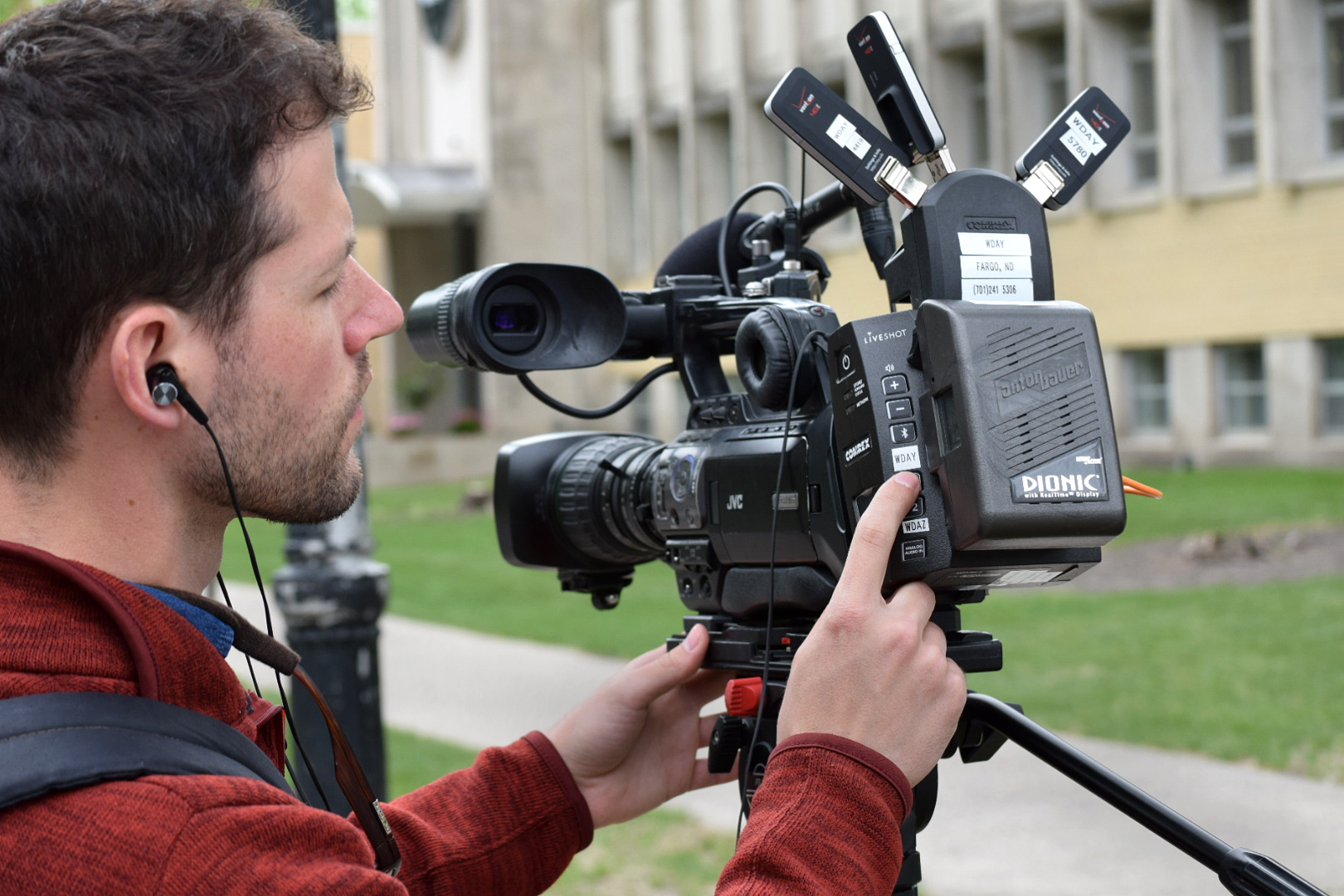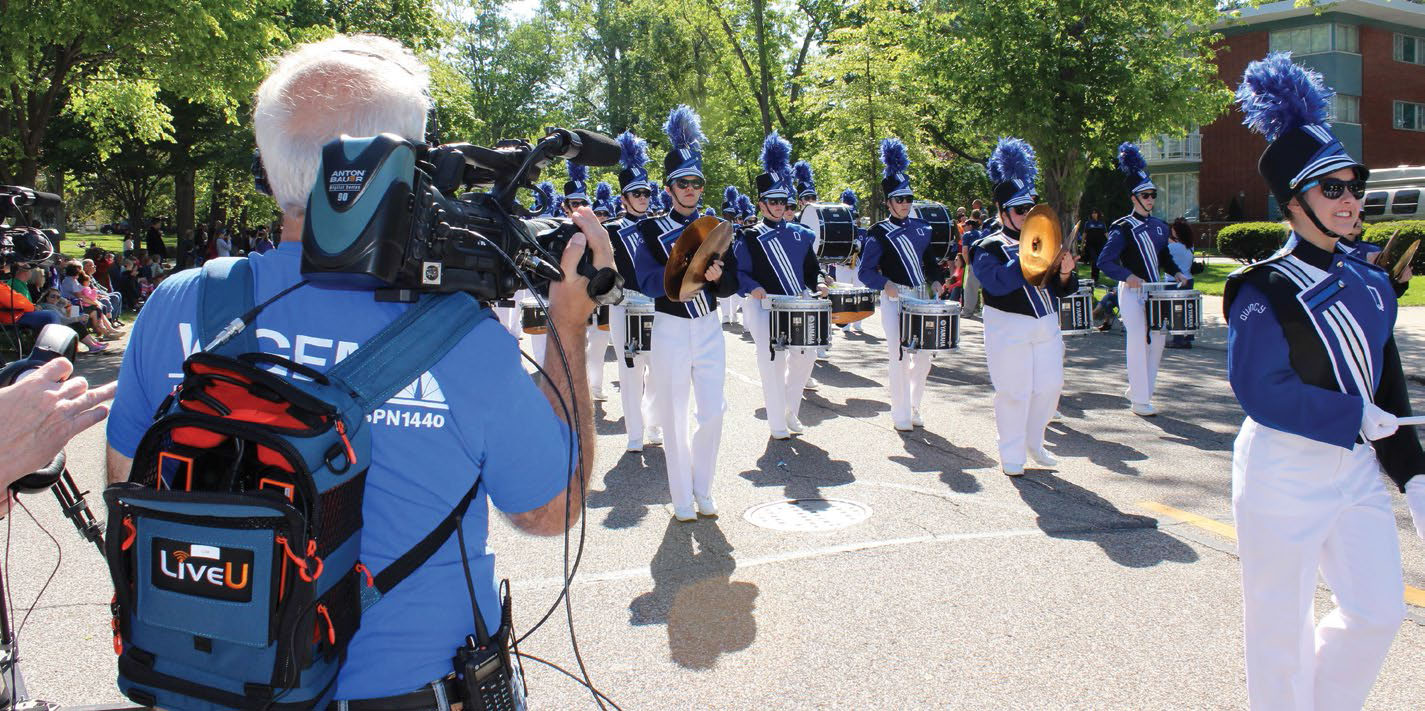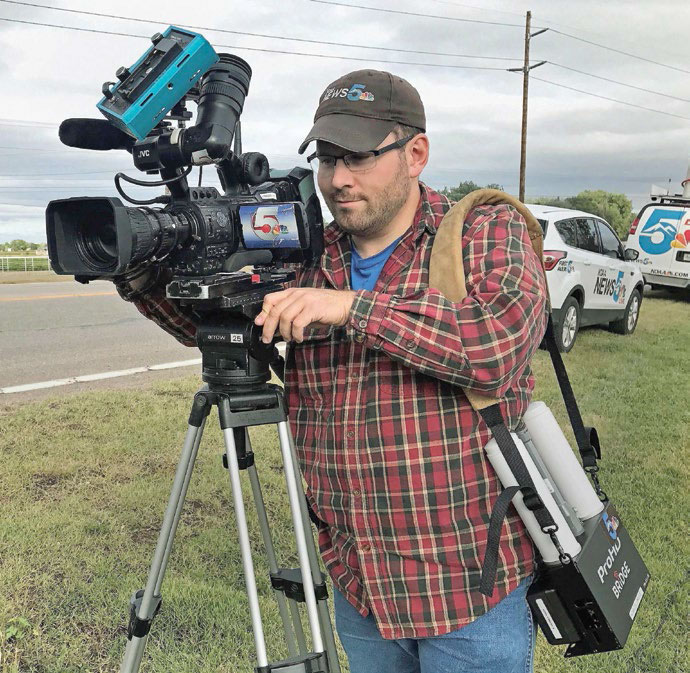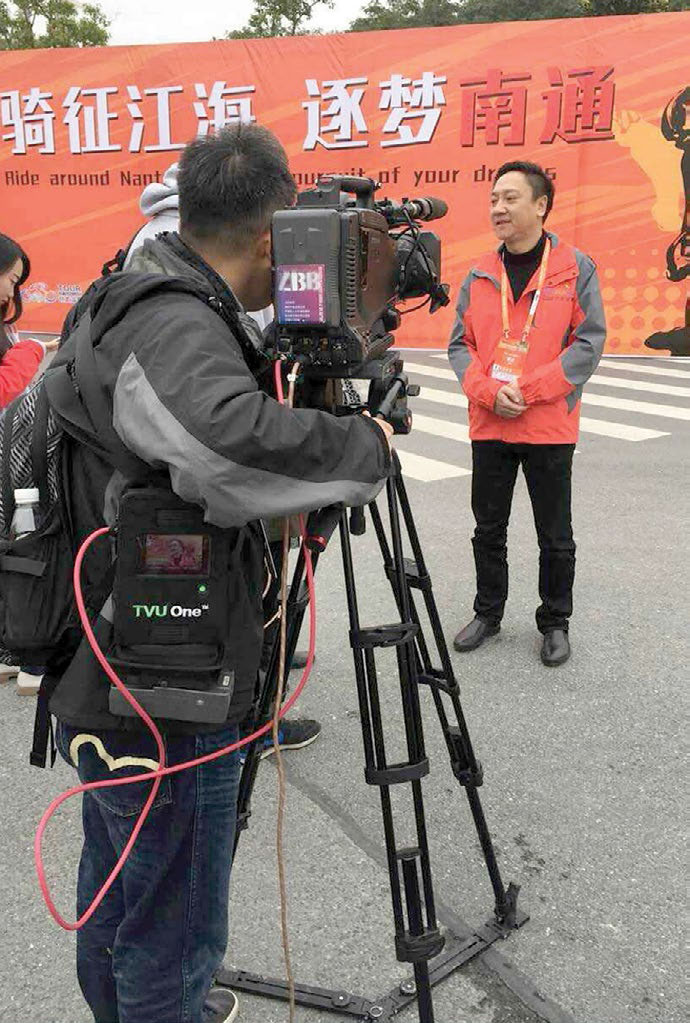Choices Grow for IP ENG News Systems
ALEXANDRIA, VA.—The television news business is all about getting the picture back from the field faster—faster than the competition, if possible. The latest tool to enable faster field video is the bonded cellular system that uses commercial mobile networks to carry video.

From a quiet start a decade ago, bonded cellular and wireless IP video products have taken off to become a major component of local news infrastructure. These portable mobile systems are far cheaper and faster to set up than a microwave or satellite truck, and they can go places—even indoors—where a truck could never go.
Jim Jachetta, executive vice president and CTO for VidOvation, the distributor for Aviwest products in the U.S., discussed the affordability factor of bonded cellular for news operations.
“As new news agencies emerge or establish agencies downsize, bonded cellular will require a much lower capital investment when compared to building citywide microwave coverage,” Jachetta said. “In some cases, satellite makes sense when the cellular network is not available. The Aviwest PRO380 system bonds up to 12 connections including eight cellular, two LAN and two WiFi. The LAN connections offer bonding of cellular with an IP microwave or IP satellite connections.”
Although bonded cellular has become important in the newsgathering toolkit, mobile network speed and reliability today are not always there when needed by broadcasters.
“It is always advised to have a variety of tools in the toolbox,” said Edgar Shane, general manager of engineering for JVC Professional Video. “Although 4G speeds, coverage, and capacity increased dramatically over the last five years, there may be conditions where cellular towers become overloaded due to great numbers of users, and satellite or microwave may be needed as a backup plan. This is especially true for large gatherings. My favorite example is New Year’s Eve in Times Square, where only microwave, satellite, or licensed wireless connections can provide reliable video transport.”
Reliability is paramount to broadcasters, who don’t want to run the risk of a remote shot failing suddenly. That’s why some manufacturers are integrating multiple paths into their bonded cellular systems.
The professional video industry's #1 source for news, trends and product and tech information. Sign up below.

“Although use of cellular data connections is one aspect of our system, the Comrex LiveShot system is capable of aggregating any viable IP network connection to transmit audio and video data,” said Chris Crump, senior director of sales & marketing for Devens, Mass.-based Comrex. “As with all public data networks, there is really no guarantee that your shared data path will be completely available and without any contention for bandwidth.”
CAMERA-MOUNT OR BODY PACK?
At the camera end, bonded cellular systems generally come in two configurations: camera-mounted or a body pack in a knapsack or shoulder-strap carrying bag. The CloudPort, from DVEO. a San Diego-based provider of broadcast gear, is an eight-modem backpack system that can be preconfigured with SIMs for a specific market. The CloudPort includes 40 GB of built-in storage to provide a solid recording of a live remote event simultaneous to the live feed.

Comrex’s LiveShot is a highly compact bonded cellular system that attaches to the back of a camera, with a docking mount for the camera’s battery. This lets any ENG broadcast camera become a mobile origination point with minimal increase in weight or size.
Change is a constant in the cellular business and the current technology for mobile connections is 4G, which is capable of wireless connection speeds of 100 Mbps or even a bit higher. (I frequently check my cellular connection speed and have twice measured connections at greater than 100 Mbps.) That is easily fast enough for excellent-quality contribution feeds from a news remote, although such speeds aren’t common in my experience and they are subject to random change as other cellular customers place demands on the service. For this reason, professional bonded cellular systems link two or more cellular modems together across multiple carriers to ensure the best possible connection and speed.
GREATER RELIABILITY
At some point in 2019, 5G cellular services will start to come online, and this is expected to provide greater reliability and bandwidth for mobile networks. However, it will not guarantee that there will be a suitable connection every time one is needed.

“The [timing and impact of 5G] is a harder question to answer than you might think,” said Dan Pisarski, vice president of engineering for LiveU in Hackensack, N.J. “One reason is there is a lot of technology, very cool tech, that falls under the ‘5G’ logo. Carriers can implement parts of this technology and not others—some examples would include deploying 5G radios but not a 5G network core, or deploying 5G in only specific frequencies while supporting 4G LTE in others. This is made more complicated because carriers are anxious to use the 5G name and are labeling some technology that standards groups might have called LTE [such as LTE Advanced and LTE Pro] as ‘5G.’
“All that said, yes, broadcasters should start to see immediate improvements even with these hybrid deployments, including more stable streams, especially at lower delays,” he added.
Initial deployments of 5G will be for fixed wireless access equipment, according to Yvonne Monterroso, head of product management for Dejero. “This equipment will provide very high data rates but will not be small size or low power,” she said. “Dejero equipment will support connection to fixed wireless access equipment via Ethernet.”
Monterroso added that later deployments (5G NR) will offer low power and portability, but the chipsets and modems are not expected to be available until mid- to late-2020. Once available, Dejero will integrate and certify these modems into its products, she said.
Once 5G networks and gear are available, Monterroso said it will mean that regular cellular customers will demand more data and content, soaking up bandwidth that broadcasters might use. However, that will take some time.
“Since 5G will take some time to be deployed and coverage will be limited, we believe that blending multiple connections will offer a compelling advantage regarding reliability and throughput, especially in mobile and nomadic applications,” she said.
SUPPORT GROWS FOR 5G
Other companies plan to support 5G for bonded cellular video acquisition gear as well.
“Aviwest and VidOvation are ready for the rollout of the 5G cellular networks,” Jachetta said. “We already have a few customers using 5G cellular and we feel that 5G conductivity will help in crowded urban areas. 5G will offer higher bandwidths over much shorter distances making it ideal for live sports venues and crowded urban areas.”
However, Jachetta pointed out that it will take time—years, probably—for wireless carriers to fully roll out 5G technology and improve their data backhaul circuits before 5G can live up to its promise. For this reason, he expects that 4G will continue to be the workhorse technology in the near term.
“While 5G cellular connectivity will help in certain locations, there will still be a need for the longer-range and wider coverage capabilities of 4G technology,” he said.

In addition to mobile 4G networks and the promise of future 5G networks, there are other connectivity options available to improve the reliability of live field acquisition. Several companies support such options, including TVU Networks.
“TVU has 5G-ready solutions today,” said Matt McEwen, vice president of product management for the Mountain View, Calif.-based provider of broadcast technology. “Our system has never been reliant on just one type of network connection technology. In fact, our system today can already aggregate virtually any cellular technology alongside WiFi, satellite, IP microwave, wired connections, etc. Just connect the active link and it will be aggregated. We expect 5G to be the same—it will just be an additional network connection that can be aggregated.”
HIGH-EFFICIENCY CODING
Another recent technology is improving the efficiency and performance of bonded cellular links: HEVC, also known as MPEG-5.

“HEVC offers higher bandwidth efficiency with the same or better visual quality than MPEG-4 AVC,” said Ronan Poullaouec, chief technology officer for Aviwest. “Using HEVC, broadcasters can achieve a 50-percent bitrate savings compared with MPEG-4 AVC. For bonded cellular news feeds, better compression means a reduction in the bandwidth needed to transmit high-quality live videos… allowing broadcasters to transmit live videos in environments where it would not have been possible to send any video with the previous MPEG-4 AVC compression technology.”
Mike Savello, vice president of sales for LiveU, said HEVC allows broadcasters to operate in real-time with extreme low latency with the highest quality, even at very low bit rates.
“This is where LiveU’s HEVC solutions differ from software solutions where video quality may be sacrificed to keep the latency low or may be switched back to H.264 to save battery life,” Savello said. “LiveU encodes in HEVC all the time, providing longer battery life.”
All the experts agreed on a tip to improve the reliability of a bonded cellular connection if you are building a new news vehicle, especially if you will be using the vehicle when it’s moving.
“With everything else being equal, I recommend antennas, more antennas, and better antennas,” said JVC’s Shane. “JVC ProHD Bridge systems utilize high-gain, diversity MIMO 4G and Wi-Fi antennas to assure reliable reception under a variety of conditions.”
Others had similar advice, each tailored to that company’s product.
“Consider the best equipment to meet the need to have a rackmount in the vehicle and/or use a mobile transmitter,” said Dejero’s Monterroso. “The Dejero mobile transmitter can be mounted in a vehicle and connected to rooftop antennas for increased cellular network reception or live shots while driving. And it can quickly be dismounted and placed in a backpack or sling bag, or mounted on a camera for mobility while on location.”
There are several smartphone apps to help broadcasters figure out coverage and ensure the most reliable shot. Of course, the wireless companies themselves have some information on their coverage.
“All cellular data providers have coverage maps to show the availability of their services down to the street level,” said Comrex’s Crump. “It’s always a good idea to try to take a look at what’s available, time permitting, at the location of a planned broadcast. There are also bunches of apps out there for the purpose determining coverage at a specific location.
"We like Open Signal and Sensorly, which provide cellular network availability data based on app user speed tests," Crump continued. "Most broadcasters that have been using IP video codecs are fairly aware of the fact that stadiums filled will 80,000 cell phones are not idea locations for an IP live shot…regardless of how many modems you are trying to use. However, in locations where local cell towers won’t be compromised, aggregating across multiple providers does tend to provide a greater degree of reliability.”
The category of mobile newsgathering products has been one of the fastest-growing segments in the broadcasting industry. Not only are these mobile products working alongside and sometimes replacing traditional backhaul methods such as microwave and satellite, the comparatively low cost of bonded cellular means that more news organizations can afford remote gear than ever.
And that is the real revolution at work in the newsgathering business—not only is bonded cellular usually cheaper and faster than the competition, it allows for video from a moving vehicle and in other circumstances that were never before possible.
Where will the revolution go next?
Bob Kovacs is the former Technology Editor for TV Tech and editor of Government Video. He is a long-time video engineer and writer, who now works as a video producer for a government agency. In 2020, Kovacs won several awards as the editor and co-producer of the short film "Rendezvous."

